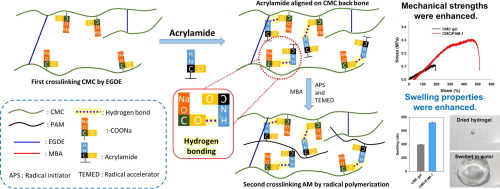当前位置:
X-MOL 学术
›
Eur. Polym. J.
›
论文详情
Our official English website, www.x-mol.net, welcomes your
feedback! (Note: you will need to create a separate account there.)
Dual crosslinked carboxymethyl cellulose/polyacrylamide interpenetrating hydrogels with highly enhanced mechanical strength and superabsorbent properties
European Polymer Journal ( IF 5.8 ) Pub Date : 2020-03-01 , DOI: 10.1016/j.eurpolymj.2020.109586 Daham Jeong , Chulgu Kim , Yohan Kim , Seunho Jung
European Polymer Journal ( IF 5.8 ) Pub Date : 2020-03-01 , DOI: 10.1016/j.eurpolymj.2020.109586 Daham Jeong , Chulgu Kim , Yohan Kim , Seunho Jung

|
Abstract Carboxymethyl cellulose (CMC)-based hydrogels possess superabsorbent properties and are biocompatible; however, their use is limited because of their low mechanical strength. In the present study, we used a sequential dual crosslinking strategy to produce new CMC-based interpenetrating polymer network (IPN) hydrogels with high mechanical strength and superabsorbent properties. The newly synthesized CMC-based IPN hydrogels were first crosslinked with CMC using ethylene glycol diglycidyl ether (EGDE) under basic conditions and were then subjected to secondary radical polymerization by adding acrylamide, N,N′-methylene bis-acrylamide (MBA), and ammonium peroxodisulfate. The structure and morphologies of the CMC with polyacrylamide (PAM) IPN hydrogels were characterized by Fourier transform infrared spectroscopy in the attenuated total reflectance mode (FTIR-ATR), solid-state nuclear magnetic resonance (NMR) spectroscopy, thermogravimetric analysis (TGA), field emission scanning electron microscopy (FE-SEM), rheology analysis, tensile test, and compressive test. The synthesized CMC/PAM IPN hydrogels exhibited highly enhanced mechanical strength with high density internal structure due to the double crosslinking of CMC and PAM. The tensile length and compressive strengths of CMC/PAM-1 IPN hydrogels were up to 2.6 and 4.5 times higher than that of the CMC gel, respectively. Moreover, CMC/PAM-1 IPN hydrogels presented higher superabsorbent properties than any other CMC-based IPN hydrogels reported so far. The present study proposes a novel method for the synthesis of CMC-based hydrogels that can simultaneously have very high mechanical strength as well as superabsorbency. These hydrogels do not show biotoxicity against in vitro animal cell and has the potential to be used as a biomaterial.
中文翻译:

双交联羧甲基纤维素/聚丙烯酰胺互穿水凝胶具有高度增强的机械强度和超吸收性能
摘要 羧甲基纤维素(CMC)基水凝胶具有高吸水性和生物相容性;然而,由于它们的机械强度低,它们的使用受到限制。在本研究中,我们使用顺序双交联策略来生产具有高机械强度和超吸收性能的新型基于 CMC 的互穿聚合物网络 (IPN) 水凝胶。新合成的基于 CMC 的 IPN 水凝胶首先在碱性条件下使用乙二醇二缩水甘油醚 (EGDE) 与 CMC 交联,然后通过添加丙烯酰胺、N,N'-亚甲基双丙烯酰胺 (MBA) 进行二次自由基聚合,和过二硫酸铵。具有聚丙烯酰胺 (PAM) IPN 水凝胶的 CMC 的结构和形态通过衰减全反射模式 (FTIR-ATR) 中的傅立叶变换红外光谱、固态核磁共振 (NMR) 光谱、热重分析 (TGA)、场发射扫描电子显微镜(FE-SEM)、流变分析、拉伸试验和压缩试验。由于CMC和PAM的双交联,合成的CMC/PAM IPN水凝胶表现出高度增强的机械强度和高密度的内部结构。CMC/PAM-1 IPN 水凝胶的拉伸长度和压缩强度分别比 CMC 凝胶高 2.6 倍和 4.5 倍。此外,与迄今为止报道的任何其他基于 CMC 的 IPN 水凝胶相比,CMC/PAM-1 IPN 水凝胶具有更高的超吸收性能。本研究提出了一种合成 CMC 基水凝胶的新方法,该方法可以同时具有非常高的机械强度和超吸收性。这些水凝胶对体外动物细胞不显示生物毒性,具有用作生物材料的潜力。
更新日期:2020-03-01
中文翻译:

双交联羧甲基纤维素/聚丙烯酰胺互穿水凝胶具有高度增强的机械强度和超吸收性能
摘要 羧甲基纤维素(CMC)基水凝胶具有高吸水性和生物相容性;然而,由于它们的机械强度低,它们的使用受到限制。在本研究中,我们使用顺序双交联策略来生产具有高机械强度和超吸收性能的新型基于 CMC 的互穿聚合物网络 (IPN) 水凝胶。新合成的基于 CMC 的 IPN 水凝胶首先在碱性条件下使用乙二醇二缩水甘油醚 (EGDE) 与 CMC 交联,然后通过添加丙烯酰胺、N,N'-亚甲基双丙烯酰胺 (MBA) 进行二次自由基聚合,和过二硫酸铵。具有聚丙烯酰胺 (PAM) IPN 水凝胶的 CMC 的结构和形态通过衰减全反射模式 (FTIR-ATR) 中的傅立叶变换红外光谱、固态核磁共振 (NMR) 光谱、热重分析 (TGA)、场发射扫描电子显微镜(FE-SEM)、流变分析、拉伸试验和压缩试验。由于CMC和PAM的双交联,合成的CMC/PAM IPN水凝胶表现出高度增强的机械强度和高密度的内部结构。CMC/PAM-1 IPN 水凝胶的拉伸长度和压缩强度分别比 CMC 凝胶高 2.6 倍和 4.5 倍。此外,与迄今为止报道的任何其他基于 CMC 的 IPN 水凝胶相比,CMC/PAM-1 IPN 水凝胶具有更高的超吸收性能。本研究提出了一种合成 CMC 基水凝胶的新方法,该方法可以同时具有非常高的机械强度和超吸收性。这些水凝胶对体外动物细胞不显示生物毒性,具有用作生物材料的潜力。







































 京公网安备 11010802027423号
京公网安备 11010802027423号